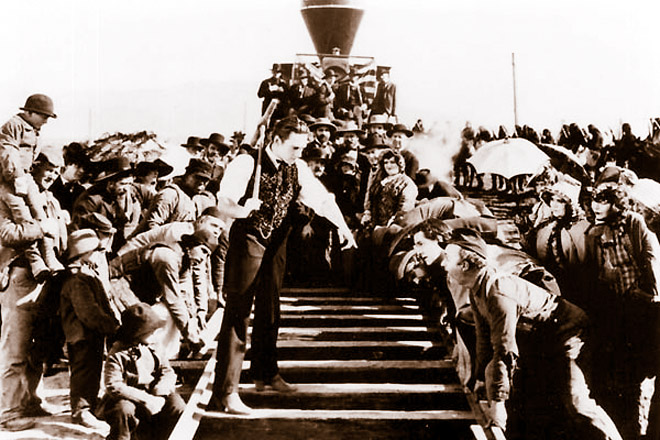Much of the mythology of the ‘Old West’ was, in fact, created by a guy from Ireland! John Ford captured this formative ethos time and time again with his simple and engrossing tales that often made you wonder where the west began and where what we call the east was situated.
Beginning in 1939, with Stagecoach and continuing through 1950 with the Calvary Trilogy (Fort Apache, She Wore a Yellow Ribbon and Rio Grande) and finally to 1962 with The Man Who Shot Liberty Valence, Ford created 10 features that largely formed the templates of the Hollywood Western. Of these, Liberty Valence was the most pensive and thoughtful.
The film takes place at that turning point in the West when the rule of force gave way to the rule of law; when literacy began to gain a foothold. It asks the question: Does a man need to carry a gun in order to disagree or state an opinion? Questions that, for the most part, our nation has yet to answer. The action takes place in the town of Shinbone, in an unnamed territory that is moving toward a vote on statehood. The lines are clearly drawn. Farmers want statehood. Cattlemen do not.
With just a few characters and a gripping narrative, Ford dramatizes the debate about guns that still resonates in many Western states today. That he does this by mixing in history, humorous supporting characters and a poignant romance is typical; his films were complete and self-contained in a way that approaches perfection. Without ever seeming to hurry, he doesn’t include a single gratuitous shot.
The men standing at the center of the story: Stoddard, Doniphon and Valance. As the film opens, U.S. Senator Ransom Stodard (James Stewart) arrives in Shinbone via the new railroad, with his wife Hallie (Vera Miles) to attend the funeral of a man named Tom Doniphon (John Wayne). The corpse is being held in a plain pine box, and when he views it, Stoddard is angered to see the boots have been stolen. An old black cowboy named Pompey (Woody Strode) takes Hallie on a buckboard ride into the countryside where they regard the burned-out remains of Doniphon’s cottage.
In a long flashback involving most of the film, Ford recalls the events leading up to that day. Years ago Shinbone was held in a grip of terror by the sadistic Liberty Valance (Lee Marvin). He had many murders on his conscience, and much enjoyed using a leather bullwhip. Tom Doniphon is a local farmer, who observes: “Liberty Valance is the toughest man south of the Picketwire… next to me.”
Valance and his two sidekicks hold up a stagecoach on the way to town, and when one of the passengers, Ransom, stands up to him, Liberty nearly whips him to death. In town he is nursed back to health by Nora and Peter Ericsson, two recent Swedish immigrants who run the local chowhouse. We also meet Link Appleyard (Andy Devine), the drunken town marshall; Doc Willoughby (Ken Murray), the drunken town doctor and Dutton Peabody (Edmund O’Brien), the editor of the paper.
Stoddard has come to town with a satchel full of law books, and hangs his shingle at the newspaper office. Liberty Valance cannot abide anyone standing up to him. He gives Stoddard a choice: Leave town, or face him in a shootout on Main Street. To one side, Doniphon observes everything but is slow to act; his strength is silently coiled. Tom has long considered Hallie to be “my girl” and is adding a room to his farmhouse that has a nice porch with a rocking chair, in preparation for the day he has no doubt she will marry him.
Stoddard believes so firmly in the law that he is willing to lose his life for his principles. The drunken marshall won’t protect him. The newspaper editor prints the truth about Valance, and for his pains has his office trashed and is whipped nearly to death.
This is clearly fascism against democracy; the tyranny of the strongman over the ordinary people. Everyone in Shinbone hates Liberty Valance, but they’re powerless against him and his two sidekicks.
There is a purity to the John Ford style. His composition is classical. He arranges his characters within the frame to reflect power dynamics – or sometimes to suggest a balance is changing. His magnificent Western landscapes are always there, but as environment, not travelogue. In a film with Lee Marvin’s snarl, Andy Devine’s squeaky voice and the accent of the Swedes, John Wayne, as usual, provides the calm center. He habitually calls Stoddard “Pilgrim”, which expresses an insight into the lawyer’s character.
The New Yorker’s Richard Brody writes, “This is the greatest American political movie. The Western is intrinsically the most political movie genre, because, like Plato’s Republic, it is concerned with the founding of cities, and because it depicts the various abstract functions of government as direct, physical actions.” The role of a free press. The function of a town meeting. The debate about statehood. The civilizing influence of education.
Ransom Stoddard is elected to the U.S. Senate because he is “The Man Who Shot Liberty Valence.” Still, one senses there is more to it than that. In John Ford’s mind, gun ownership was very much an open question. The screenplay by James Warner Bellah and Willis Goldbrick contains one of the best known lines of dialogue in any Ford movie, spoken to Stoddard years later by the town’s new newspaper editor: “This is the West, sir. When the legend becomes fact, print the legend.”






